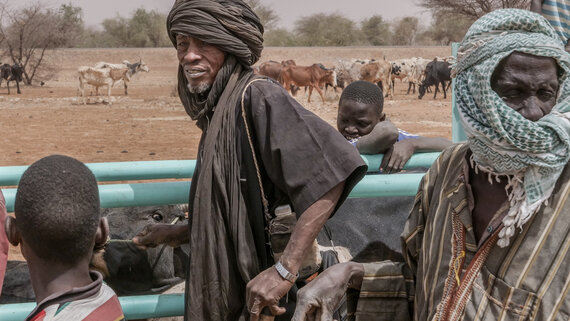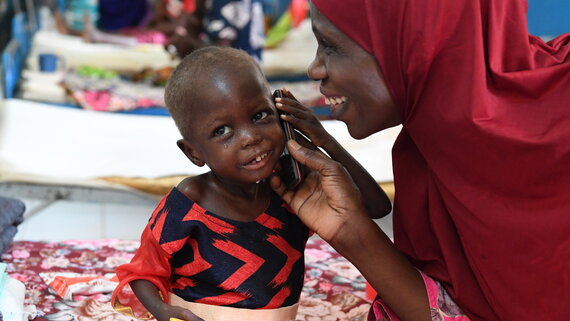Analysis of the context, crisis and needs
Niger faces a broad range of complex humanitarian needs linked to escalating conflict-related violence, climate-related disasters and socioeconomic challenges. The number of people in need has increased by 65 per cent, from 2.3 million in 2019 to 3.8 million in 2021. Violence related to the activities of armed actors in the country and surrounding areas in Mali, Burkina Faso and Nigeria has led to severe protection concerns and aggravated chronic food insecurity and malnutrition. This is caused by the effects of climate change as well as limited access to essential social services in a context of high-level poverty in certain areas. Moreover, due to insecurity, many farmers, including internally displaced persons (IDPs), cannot carry out the agricultural activities that represent their primary source of livelihood.
Despite the returns of around 65,000 IDPs in Diffa and Tillabery in 2021, the number of IDPs in Diffa, Maradi, Tillabery and Tahoua reached over 264,000 in September 2021, a 41 per cent rise compared to September 2019. The Government plans to organize the return of about 104,600 IDPs by the end of December 2021. Niger is home for almost 250,000 refugees, an increase of 42 per cent over the past three years but over 17 per cent over the past two years.

Tillabéri, Niger
In Niger, as in many other countries in the Sahel, livestock herders face a double threat to their way of life. Pastureland is shrinking at an alarming rate as temperatures rise and rainfall decreases due to climate change. At the same time, the presence of armed groups along traditional transhumance routes has made it dangerous to search for greener pastures. This herder has settled in Tillabéri. He explains: “There never used to be any security problems. We herders went wherever we liked. It was rare to see animals die of hunger. Now the pastures are cut off from us.” Increasingly scarce resources, a lack of economic prospects and an ever-growing population have pitted farmers and herders against each other, causing tensions that sometimes degenerate into violent clashes between different groups.
ICRC/Birom SeckThe main protection concerns in conflict-prone areas include human rights violations and abuses affecting civilian populations, especially in Tillabery, Tahoua, Diffa and Maradi. The number of protection incidents has increased significantly over the past two years. From January to July 2021, some 2,375 protection incidents were registered against 1,500 incidents for the whole of 2019, and 705 civilians were killed, surpassing 409 in the whole of 2019.
Food insecurity is a long-standing issue affecting millions of people every year. Overall, 8 million people were under pressure from or affected by food insecurity during the 2021 lean season (June-August), including 2.3 million severely affected (IPC phases 3 and 4), according to the findings of the March 2021 Cadre Harmonisé. Furthermore, 450,000 severely malnourished children out of 1.6 million children are affected by acute malnutrition. The global acute malnutrition rate among children under 5 years of age reached 12.7 per cent in 2020, which is above the WHO emergency threshold of 10 per cent. In addition to the COVID-19 pandemic, Niger faces frequent disease outbreaks such as cholera, measles, meningitis compounded by malnutrition, among other things, and the effects of extreme weather events, especially floods and drought. Finally, Niger is dealing with recurrent floods during the rainy season. As of October 2021, torrential rainfall destroyed 11,521 homes and affected 250,331 people, including 77 deaths. Last year, flooding affected over 630,000 people.

Niamey, Niger
This 75-year-old fisherman from Saguia looks at the space where his house once stood. It was flooded by heavy rainfall in his neighbourhood in October 2020, he lost his house and livelihood but found refuge at the Gamou IDP site in Niamey.
OCHA/Michele CattaniThe lingering effects of climate change combined with challenges to address the root causes of the endemic poverty, limited access to essential services and livelihoods, and human rights violations in conflict-affected areas will likely continue to affect the protection of the most vulnerable communities and increase their humanitarian needs.
Underfunding remains a major constraint for humanitarian operations, with the 2021 Humanitarian Response Plan only 39 per cent funded as of mid-November. Despite the limited resources, humanitarian actors, in coordination with partners from State services, assisted about 1.4 million people, or 67 per cent of their target. However, more funding would ensure no one is left behind. It would enable more resilience actions to reverse the trend of increasing humanitarian needs of the most vulnerable communities without adequate and well-coordinated short- and long-term solutions.
Projected situation in 2022 and beyond
Overall, 3 million people will need humanitarian assistance in Niger in 2022. The number of people in need in 2021 was an estimate based on a high probability of the severe socioeconomic impacts of COVID-19. However, the consequences of the pandemic happened to be lower. COVID-19 has been considered as part of the humanitarian contextual analysis for 2022. The number of people in need in 2022 is a provisional figure pending the release of the results of the food security projections through the Cadre Harmonisé and the findings of the national nutrition survey (SMART) in November 2021. The identified needs are multisectoral, and their degree of severity varies across departments and the three affected groups of internally displaced persons (IDPs), refugees and host communities. The erratic rainfall in many agricultural areas in 2021 suggests a poor harvest for crops and fodder, which may increase the number of food-insecure people and malnourished children.

Maradi, Niger
Seventeen days before this picture was taken, this girl was found on the street, severely malnourished. The traditional village chief took her to the health centre in Maradi. A nutrition specialist (next to her in the picture) took care of her. Once the girl recovered, she remembered the name of her parents, social workers are now looking for them. In the meantime, she is staying in the health centre and the nutrition specialist is caring for her as if she were her own daughter.
UNICEF/Frank DelongResponse priorities in 2022
As of 30 September, 926,362 people (72 per cent of the target) received food assistance, and 908,443 people (81 per cent of the target) received WASH assistance. Lack of access and insufficient resources prevented more people being reached, especially in hard-to-reach areas with acute humanitarian needs.
The humanitarian community projects 3 million people will need multisectoral assistance in 2022. The response targets the vulnerable groups in acute need, factoring in their preferences and priorities, the access constraints and the response modalities, the severity of the needs, the gender dimension, and the clusters’ operational capacity to deliver. The prioritization has also considered the intersectoral aspect of the need and included strategic outcome-level targets for 2022 to further improve response.
Niger HRP
Considering the Government has launched a return operation for people displaced since 2015, contributing to durable solutions for IDPs would be explored where possible, particularly in non-active conflict areas. Moreover, in some regions, the drivers and underlying causes of needs are rooted in structural deficiencies. A coordinated approach among humanitarian, development and peace (HDP) and transition actors is needed to ensure areas with high vulnerabilities are addressed collectively through sequencing and layering of interventions to reduce people's self-defined needs under the framework of the HDP nexus in 2022 for a better complementarity in the response.
Further reading
Source: OCHA
Source: Humanitarian Insight
Source: Financial Tracking Service
References
- Niger's economy largely depends on agriculture and livestock, accounting for 40% per cent of its GDP, according to the World Bank.
- UNHCR operational data portal.
- Refugees are mainly from Nigeria and Mali.
- This includes killings, rape, forced displacement, destruction of properties, illegal tax collection, destruction of public infrastructures such as schools and health centrers, and abductions.
- As of mid-September 2021, a cholera epidemic has affected over 4,000 people including 140 deaths.



